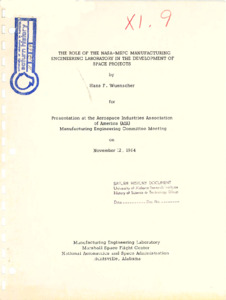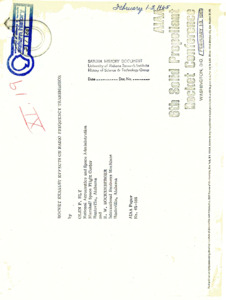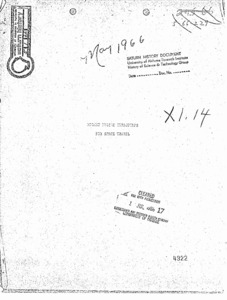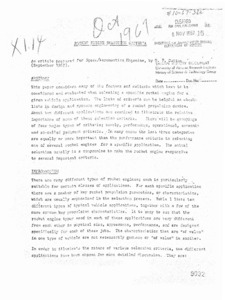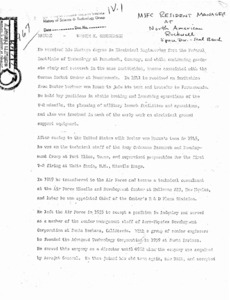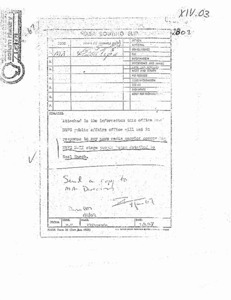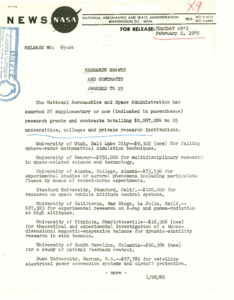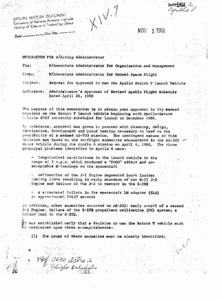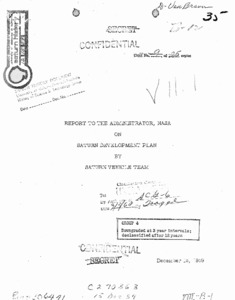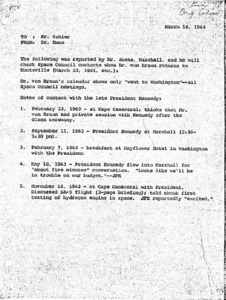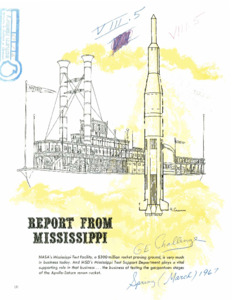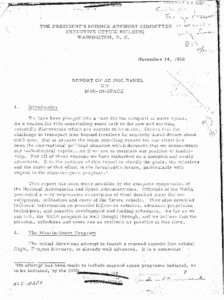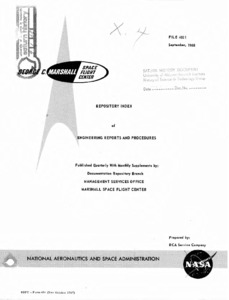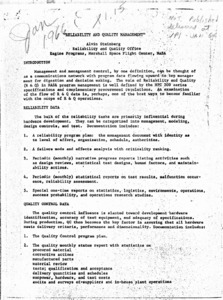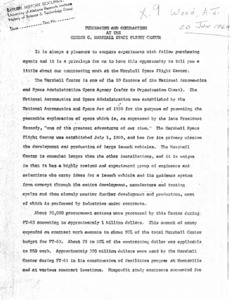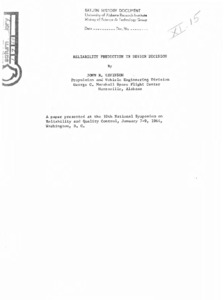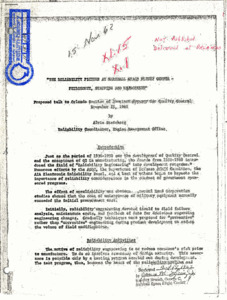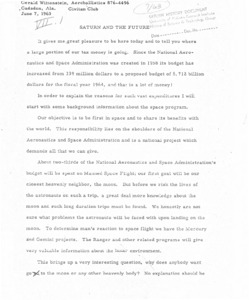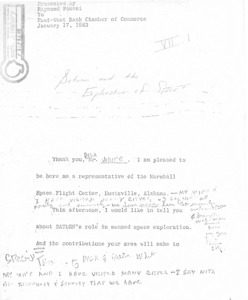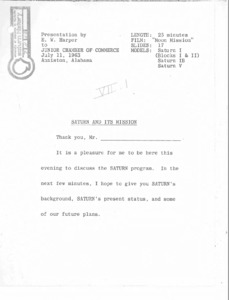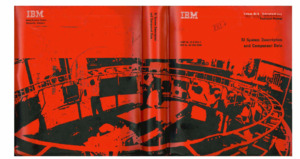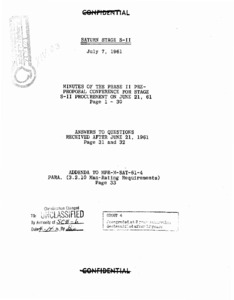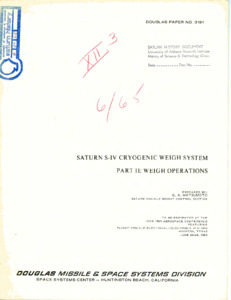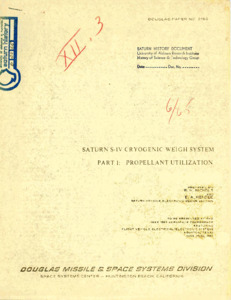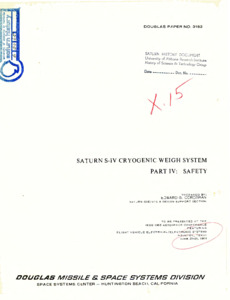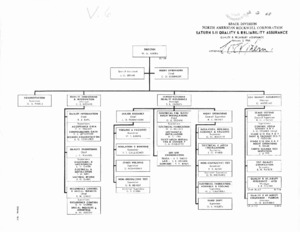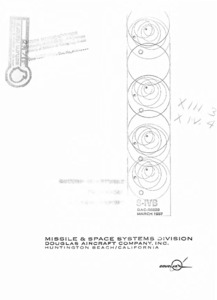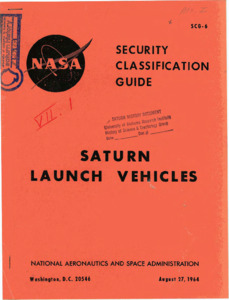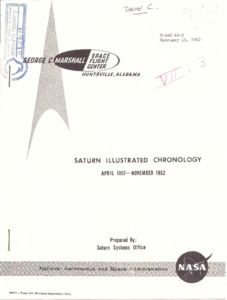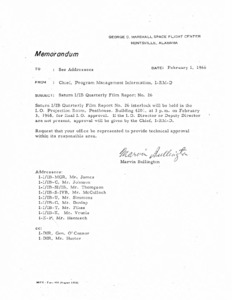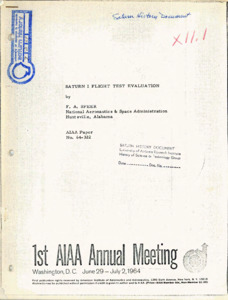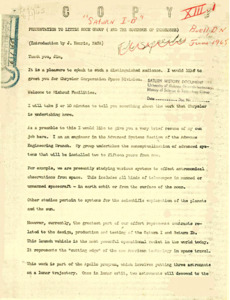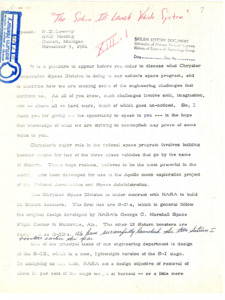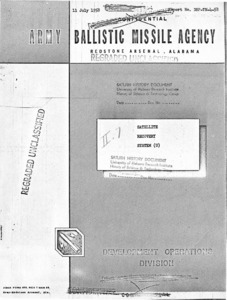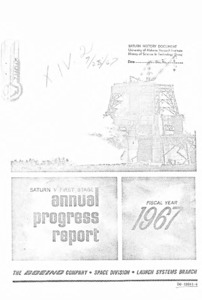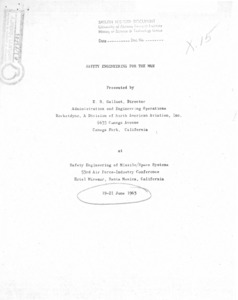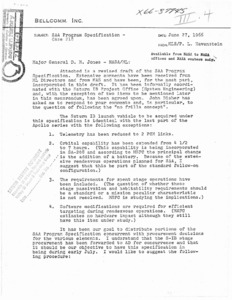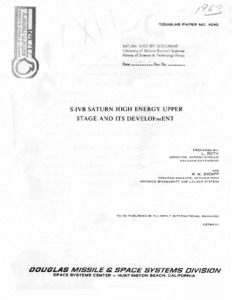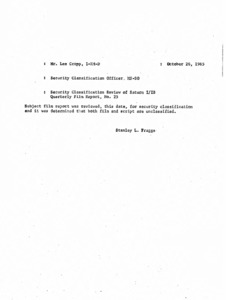
Browse Items (6320 total)
Sort by:
-
"The role of the NASA-MSFC Manufacturing Engineering Laboratory in the development of space projects."
For presentation at the Aerospace Industries Association of America (AIA) Manufacturing Engineering Committee Meeting. Discusses the role the NASA Engineering Laboratory has had on NASA projects in the form of vehicles and smaller projects. -
"Rocket exhaust effects on radio frequency transmission."
Presented by Olen P. Ely, National Aeronautics and Space Administration, Marshall Space Flight Center, Huntsville, Alabama and R. W. Hockenberger, International Business Machines. Paper that explores the effects of rocket-engine exhaust on radio-signals. -
"Rocket engine turbo pumps for space travel."
Finding the turbopump arrangement which is best suited for a given rocket engine - space travel applications - constitutes an important task. The arrangement depends upon a large variety of different factors, such as, the engine cycle, weight, the liquids to be pumped, the cavitation performance, the bearings and their lubrication, the seals and the turbine. In this report these factors and their influence on the turbopump configuration are discussed. It is shown that three of them: weight, propellants to be pumped and obtainable suction performance have the largest influence on the selection of the turbopump. A systematic approach is outlines for the design process, which allows to arrive at a turbopump arrangement best suited for a given application. -
"Rocket engine selection criteria."
This paper considers many of the factors and criteria which have to be considered and evaluated when selecting a specific rocket engine for a given vehicle application. The lists of criteria can be helpful as checklists in design and systems engineering of a rocket propulsion device. About ten different applications are examined to illustrate the relative importance of some of these selection criteria. There will be groupings of our major types of criteria; namely, performance, operational, economic and so-called judgment criteria. In many cases the last three categories are equally or more important than the performance criteria in selecting one of several rocket engines for a specific application. The actual selection usually is a compromise to make the rocket engine responsive to several important criteria. -
"Resume - Werner K. Gengelbach."
Letter vouching for the expertise and past accomplishments of Werner K. Gengelbach -
"Response to any news media queries concerning MSFC S-II stage."
Letter to answer any incoming questions from the media regarding the MSFC-II stage and any briefed on Seal Beach. -
"Research grants and contracts awarded to 25 : NASA news."
Press-release detailing 27 research grants sent to numerous universities. -
"Request for approval to man the Apollo Saturn V Vehicle."
The purpose of this memorandum is to obtaln your approval to fly manned missions on the Saturn V launch vehicle beginning with Apollo-Saturn vehicle #503 currently scheduled for launch in December 1968. -
"Report to the administrator, NASA on the Saturn development plan."
In anticipation of this transfer, the NASA and Department of Defense have established, an interim working agreement that provides for immediate assumption by NASA of responsibilities fortechnical management of the Saturn vehicle development. -
"Report to Mr. Sohier from Dr. Emme."
Report detailing dates of Dr. Akens Marshall meetings with President Kennedy. -
"Report From Mississippi."
Report detailing the progress NASA's Mississippi test facility has made testing the Apollo-Saturn rocket. -
"Report of Ad Hoc panel on Man-in-Space."
It is the purpose of this report to clarify the goals, the missions and the costs of this effort in the forseeable future, particularly with regard to the man-in-space program -
"Repository index of engineering reports and procedures."
This index is an inventory of engineering reports and procedures available in Repository files. The Repository files contain various headquarters, MSFC, MSC, KSC and contractor prepared documents related to the overall MSFC, Apollo Program Requirements. V.C. Sorensen, Chief Management Services Office.; Published quarterly with monthly supplements by: Document Repository Branch; Management Services Office; Marshall Space Flight Center. -
"Reliability and quality management."
The role of Reliability and Quality in NASA program management is well defined by the NPC 200 series and complimentary procurement regulations. -
"Purchasing and contracting at the George C. Marshall Space Flight Center."
This is a speech given to fellow purchasing agent regarding purchasing and contracting. -
"Reliability prediction in design decision."
This paper presents some case histories in which reliability prediction plays an important role. -
"The reliability picture at Marshall Space Flight Center - philosophy, staffing and management. Proposed talk to Orlando Section American Society for Quality Control."
Document that discusses the importance of reliability in engineering. -
"Saturn and the future."
Presentation with its main focus on the competitive and humanitarian goals of the Saturn project. -
"Saturn and the exploration of space."
Presentation Raymond Pisani to the East-West Bank Chamber of Commerce regarding the Saturn project's roll in space exploration and what contrabutions the East-West Bank can make in that area. -
"Saturn and its mission."
Presentation from Harper, discussing the Saturn Project's then-status, background and plans. -
"Saturn IB/V Instrument Unit system description and component data: technical manual."
This manual contains a brief description of each Instrument Unit (IU) system and their respective components for S-IU-201 through 212 and S-IU-501 through 515. -
"Saturn stages S-II : July 7, 1961 : Minutes of the phase II pre-proposal conference for stage S-II procurement."
Transcription of a confrence aiming to propose ideas for new rocket designs. Includes references to slides. -
"Saturn S-IV cryogenic weigh system. Part II : weigh operations."
Two basic methods for mass determination are: (1) direct measurement, (2) volume and density determination. Both methods or variations have been used to determine space vehicle propellant mass with varying degrees of success. Stringent propellant loading accuracy requirements of k0.5 percent for the Saturn S-IV Stage have led to the development of a Cryogenic Calibration Weigh System. The method employs accurate electronic force transducers and measuring systems as the standard and experimental weighings have verified achievement of better than the required accuracy. -
"Saturn S-IV cryogenic weigh system. Part I : propellant utilization."
In order to achieve maximum vehicle efficiency, it is essential that the vehicle propellants be loaded to desired values and that these propellants approach simultaneous depletion at the end of powered flight. To accomplish precise loading and assure minimum residuals, a highly accurate and repeatable, vehicle located, propellant management (PM) or propellant utilization (PU) system must be used. As the ability to load propellants to predetermined values depends directly on the ability of the system to accurately sense the propellant masses, it is essential that the system be calibrated with respect to propellant mass under conditions resembling those to be experienced during final loading and powered flight. The use of a cryogenic weight system will reduce the unknown factors in capacitance sensor element shaping, tank geometry, and propellant properties to a degree which will permit the determination of propellant masses to with .025%. -
"Saturn S-IV cryogenic weigh system. Part IV : safety."
During cryogenic weigh system operation, hydrogen when combined with oxygen can create an unsafe condition. Therefore the concentration of the residual oxygen and hydrogen from leaks in the cryogenic weigh environmental bags must be known at all times during the cryogenic weigh. Hydrogen and oxygen detectors will provide the optimum method for maintaining safe conditions. Hydrogen properties and safe mixtures are reviewed. The method selected to analyze the oxygen content is discussed. The selection, development, and testing of a hydrogen detector system is examined. -
"Saturn S- II quality & reliability assurance : quality and reliability assurance" Organizational Chart.
Organizational Chart of the Rockwell Corperation, 1968 -
"Saturn S-IVB quarterly technical progress report."
Douglas Aircraft Company Report DAC-56533, Saturn S-IVB Quarterly Technical Progress Report, covers design and development progress on the Saturn IB and Saturn V configurations of the S-IVB stage during January, February, and March 1967. This report is prepared for the National Aeronautics and Space Administration under Contract NAS7-01.; Prepared for National Aeronautics and Space Administration under NASA contract NAS7-101.; Approved by A. P. O'Neal, Director, Saturn Development Engineering. -
"Saturn launch vehicles : security classification guide."
This security classification guide is a compilation of previous individual classification assignments. Consideration of international affairs, the use and development of advanced technological information, and requirements of flight safety have influenced these assignments. -
"Saturn illustrated chronology : April 1957 - November 1962."
Document detailing the history of the saturn project between April, 1957 through November, 1962. -
"Saturn I/IB quarterly film report no. 26."
Memo is from Chief, Program Management Information, I-RM-D.; The date and time of the interlock for the final I.O. approval is given. -
"Saturn I flight test evaluation."
As this paper is being written, the Saturn I flight test program includes five flights launched between October, 1961 and January, 1964. All five fiights were complete successes, both in achieving all major test missions and in obtaining an unprecedented volume of system performance data for flight analysis. -
"Saturn IB/V instrument unit."
This brochure provides some basic, general information about the lnstrument Unit, a very important part of the Saturn IB and Saturn V launch vehicles. These launch vehicles are being developed primarily for the Apollo program for manned lunar exploration but will also be used for future space missions. -
"Saturn IB : presentation to Little Rock Group."
Speech by H.D. Lowrey, SAE Meeting, Detroit, Michigan. Focuses on the Apollo project, the technology involved and what the goals of the project are. -
"The Saturn IB launch vehicle system."
Speech containing information regarding Crystler's role in the Saturn Project as contracted builders of the stages of three space vehicles. -
"Satellite recovery system."
Report focusing on the problems of the satalite recovery system and the possible solutions for those problems. -
"Annual progress report :1966-1967."
The Annual Progress Report from July 1st, 1966 through June 30thm 1967. -
"Safety engineering for the man."
Presented at Safety Engineering of Missile/Space Systems, 53rd Air Force - Industry Conference, detailing potential safety issues within the Atlas weapon system. -
"SAA program specification - case 218."
Memo sent to Major General D. M. Jones - NASA/ML. -
"S-IVB Saturn high energy upper stage and its development."
The development of carrier rockets For manned space missions has been one of the major activities in the aerospace field during the past decade. The early space efforts were made possible by the existence of large ballistics missiles. It soon became obvious that the delivery of weapons and the launch of large spacecraft could not be combined into one operational system in an efficient way; therefore, a family of spacecraft boosters had to be created. -
"Security classification review of Saturn I/IB quarterly film report, no. 25."
Memo to Mr. Lee Cropp, I-RM-D.
